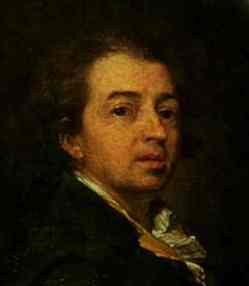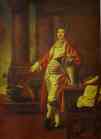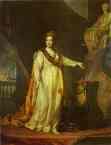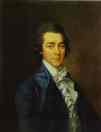Dmitry Levitzky Biography

Dmitry Grigorievich Levitzky is, without doubt, the leading Russian painter of the latter half of the 18th Century, as well as the first Russian painter to paint at the level of contemporary Western European masters. Levitzky specialized in the art of the portrait, which was in great demand in Russian high society at the time, as it sought to emulate its counterparts in the rest of Europe. He is the most universal of his contemporaries, both in terms of subjects -- ranging from the serf Nikifor Sezemov to the Empress Catherine II, the Great, herself -- and in terms of composition. His works are characterized by a unique style that set him apart from other Russian painters of the period. The manner in which he imbued his portraits with finely expressed emotions is, in some ways, far ahead of his time. Levitzky is sometimes known in the West as "the Russian Gainsborough."
Levitzky was probably born in Kiev, in the middle of May, 1735. There is no record of his exact birth date, but a church record from 1754 notes that Dmitry was 19 at the time. His birthday is believed to have been somewhere between May 13 and May 17 (Old Style; May 26 and May 30 New Style). His father was Grigory Levizky-Nos, a priest in the village of Mayachky and a prominent engraver. It was his engraving work that caused him to spend much time in Kiev. It was he who first taught the young Dmitry art.
Between 1752 and 1755, Aleksey Antropov, one of the most significant Russian painters of the time, was working in Kiev on a commission to paint frescoes and iconostases in the Kiev Cathedral of St. Andrew, and it was probably during this period that he first met Levitzky. The young painter followed his teacher to St. Petersburg, and a record from 1758 lists him as one of Antropov's pupils and a resident in Antropov's household. He stayed with his teacher until at least 1764.
During this time, he probably attended the lessons of Jean Louis Lagrenée, a tutor at the Academy of Arts in St. Petersburg, though he was never officially enrolled at the Academy. Giuseppe Valeriani is often suggested to be another of Levitzky's teachers.
As part of his apprenticeship to Antropov, Levitzky took part in the decoration of two of triumphal arches in Moscow, which had been constructed for the coronation of Catherine II. The work included icons, allegorical paintings and eight portraits. In 1766, he was commissioned to paint a large number of icons for three newly-built churches in Moscow. Unfortunately, none of these works survived to modern times.
In 1770, Levitzky first became famous as a portrait painter after the exhibition of 6 of his portraits at the Academy of Arts in St. Petersburg. For the Portrait of Alexander Kokorinov (1769) he was given the rank of academician and, in 1771, appointed the professor of portrait painting at the Academy of Arts. He would work in this position until 1787. In 1776, he was elected a councillor of the Academy, and in 1780, became a member of the Academy Council.
However, his good standing in the Academy was not to last and in August 1787, the painter wrote to the Academy Council, asking them to relieve him of his duties because of "declining health and vision." Since the painter would work actively for another 25 years, this would doubtfully the real cause. The Academy assigned him a miserly pension of some 200 rubles a year.
The 1770s and 1780s were the painter's most productive time. Notable portraits of this period include the Portrait of Prokofiy Demidov (1773), Portrait of Catherine II as Legislator in the Temple of the Goddess of Justice (1783), Portrait of Maria Dyakova (1778), Portrait of Nikolay Lvov, Architect, Painter and Poet (1780). Between 1772 and 1776 Levitzky worked on a series of portraits of the pupils of the privileged Smolny Institute for Young Ladies in St. Petersburg, commissioned by Catherine II, among them, the Portrait of Ekaterina Nelidova (1773) and 6 other portraits. All the subjects were the best pupils of the Institute and they are depicted performing dances, music and drama.
After leaving the Academy, the painter's popularity began to decline. He stopped receiving commissions from the court and gentry and his financial situation gradually got worse and worse. In 1807, the Academy softened its attitude towards the painter and appointed him to the Academy Council "in view of his years, rank and past fame," boosting his pay to 600 rubles per year, which improved his position considerably.
Sometime in the late 1790s, the painter joined the masonic lodge "The Dying Sphynx".
Notable works of this later period include portraits of the daughters of Paul I, paintings of the Vorontsov family, and pictures of Nikolay Novikov, the Bilibins, Anna Protasova, and others.
Dmitry Levitzky died in St. Peterburg on April 4 (Old Style; April 17, New Style), 1822, just a month shy of his 87th birthday.
Bibliography
Russian Painters. St. Petersburg. 1998. (in Russian)
The Art and Architecture of Russia (Pelican History Art) by George Heard Hamilton. Yale Univ Pr, 1992.
A Dictionary of Russian and Soviet Artists 1420-1970 by John Milner. Antique Collectors' Club, 1993.
- Portrait Of Alexander Kokorinov, Director And First Rector Of The...

1769. Oil on canvas. The Russian Museum, St. Petersburg, Russia. Read Note.
- Portrait Of Prokofiy Demidov.

1773. Oil on canvas. The Tretyakov Gallery, Moscow, Russia. Read Note.
- Portrait Of Catherine Ii As Legislator In The Temple Of The Goddess Of...

1783. Oil on canvas. The Russian Museum, St. Petersburg, Russia. Read Note.
- Portrait Of Maria Dyakova.

1778. Oil on canvas. The Tretyakov Gallery, Moscow, Russia. Read Note.
- Portrait Of Nikolay Lvov, Architect, Painter And Poet.

1780s. Oil on canvas. The Russian Museum, St. Petersburg, Russia. Read Note.